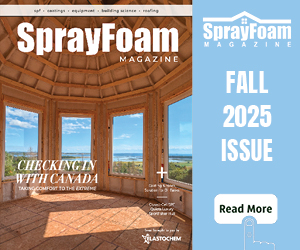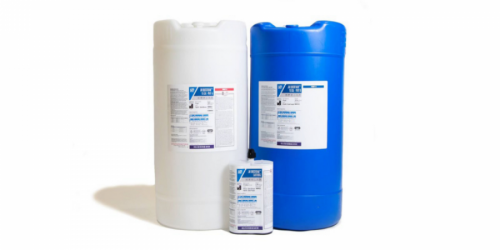Q&A Forums
Closed cell foam vs air circulation Post New Topic | Post Reply
| Author | Comments |
|---|---|
|
frank yokubeak
Posted: Mar 20, 2007 08:22 AM
|
Closed cell foam vs air circulation
I live in NW Penna. and am having problems with ice damming on my roof. I contacted a contractor who wants to apply closed cell foam to the underside of the roof. I have always been told that you must have free air circulation to the underside of the roof to increase the life of asphault shingles. Where can i go to get more information on this?
|
|
quentin
Posted: Mar 20, 2007 06:58 PM
|
I have done some research on this and the contractor you talked to is right. If you send me your email I can send you some papers on it from research done by industry groups for the construction industry and not just foam supporters. Here is link from this site too that could be helpful to you. https://sprayfoammagazine.com/blps/blg_viewart.cfm?bid=11&artID=21 I can't find it right off but one of the members here has a video with a full explanation of thy you do not need it with foam in an ad they posted for their company. It was very well done and shows them doing sealed attic systems instead of vented attics. In a nutshell, other insulation require air movement since they do not seal strait to the underside of the roof but since sprayfoam does it prevents the thermal transfer back and forth. Especially with fiberglass and other products you have air movement in the insulation while foam you do not as well as it having direct contact with the surface. Also if you use fiberglass you may want to look at seeing what it would costs to redo any uninsulated areas as fiberglass actually drops the R value by 50% once you get below about 32 degree Fahrenheit due to air movement within the actual insulation. This is beyond the air leakage you get with that junk. BTW, no I am NOT a contractor for foam.....yet. I am trying to get in to it after doing research on foam for4 someone else and am impressed enough to really believe in it. The more I learn the more I am impressed also. |
|
frank yokubeak
Posted: Mar 21, 2007 03:34 PM
|
Thanks for the link but I do not think that it addresses the issue of the life of shingles. I did call Owens Corning and Certinteed and they both felt that there would be warranty issues concerning ventilation clauses in the warranty. Here is my e-mail address: fyokubeak@neo.rr.com I would be glad to see more on this. |
|
Posted: Mar 21, 2007 03:42 PM
|
http://www.buildingscienceconsulting.com/resources/4-Understanding_Attic_Ventilation.pdf Here is a long, in depth article regarding attic ventalation. The way I understand it is that shingle life will be shorter in an unvented attic where spray foam is applied to the underside of the roof deck. Just going from memory I think average shingle life should be around 10 years, where as it may be as low as 7 years with the un-vented attic. Hope this helps. |
|
Posted: Mar 21, 2007 03:48 PM
|
I just browsed through the article and it states that a 10% decrease in shingle life should be expected, but it really depends on your climate. |
|
quentin
Posted: Mar 21, 2007 04:15 PM
|
What I have read says they think it may but there is no real evidence beyond a theory it may reduce shingle life. Of course Owens Corning has a very real interest in that theory since they sell both fiberglass insulation AND shingles so you may want to watch that angle. I'll email some studies I have found and etc. Interesting they are the ones that void the warranty though. A 5-10 degree increase in the surface temperature in summer and their products can’t handle it? I wonder how well their products do in hot climates like Florida then and if they refuse to warranty them there. I would be asking them that question. http://www.myhomeimprovement.com/?page=prev_ques&qid=3535&m=68 Question: I currently have a vaulted home with 4x6 beams, 1 inch tongue and groove on top of beams, on top of tongue and groove is 2x6's with only 3/4 inch bead board insulation with soffit vents and ridge vent. Can I remove the roofing and sheeting and spray 3 inches of foam on top of the tongue and groove and re sheet and shingle? If I do that do I need to ventilate the remaining space above the foam? If you don't ventilate will there be a heat and moisture problem shortening the shingle life? Answer: Yes...in fact it would be the easiest way to do it. Spraying from the outside eliminates the need to protect interior finishing. If you spray 3-4 inches of foam atop the tongue & groove there will actually be space for air to travel if access to the overhang is left open. It is not necessary to vent as the foam eliminates air infiltration so you certainly could fill the entire cavity with foam also. A hot roof (sealed roof with no venting) will raise the temperature of the shingles between 5-10 degrees which most shingles manufacturers (Elk, Certainteed-IKO-CRC) agree will not decrease the life of the shingle. (the same shingles are used in P******nix and shingles installed there will be much hotter than 5-10 degrees above what we see here) However, there are two manufacturers (GAF & Owens-Corning) that I know of that will void their warranty if ventilation is not installed. If you choose not to ventilate, do not install these shingles. (I feel Elk makes the best shingle anyway...and they will warranty a hot roof) This is one of the studies I found on it and it explains things pretty well if you have a technical mind. http://www.buildingscience.com/icon_download.jpg And finally, this site has some good answers to your question. Interesting that he is able to cite a study done showing that it is the shingle COLOR and not the venting that really controls shingle temperatures. I think the answers you are getting from the shingle companies seems more like a self interest issue in their also selling insulation and venting products than looking at the science and realities. That or they are trying to hide selling inferior products they are selling. |
|
Posted: Mar 21, 2007 07:29 PM
|
What is the visible sign of the "damaged" shingles? Do they shrink and curl up? Here the winter does a number on the shingles, most houses even with premium shingles installed will need to replace their roofs every 10 years anyway. Tim Granite State Spray Foam Co. |
|
Todd Baxter
Posted: Mar 22, 2007 08:25 AM
|
look up elk roofing and they talk about how it will help the roof life. |
|
quentin
Posted: Mar 22, 2007 09:49 AM
|
I tried to email you but RR HATES my email since I use and run my own domain and email server. LOL |
|
Aaron Scurlock
Posted: Mar 22, 2007 10:40 AM
|
Now beware...Elk was just bought up by GAF and those warranties could easily change. |
|
philip mullins
Posted: Mar 27, 2007 12:10 PM
|
i know a little something about the 'ethics' (or lack there of) of these shingle companies. after hurricane katrina all you could get down here were the most expensive archictual shingles made. the manufacturers flat out refused to ship the cheaper 3tab shingles. the proof is in the puding. you can ride through the getto here and every roof has arch. shingles. and i am not a roofer but, i am pretty sure that those things werent 60 bucks a square b4 katrina. just somethings you may want to consider when dealing with peeps who eat thier young! |
|
Todd Baxter
Posted: Mar 27, 2007 02:57 PM
|
3 tab shingles are junk. you cant use them in fla. So I hope if you live the gulf you would want them better wind rating. |
|
Gerry Wagoner
Posted: Mar 28, 2007 11:20 AM
|
Both Elk and Certainteed will warranty unvented roof assemblies. Oak Ridge Laboratories did some research and concluded that shingle life is not shortened at all by a non-vented attic. They further concluded that shingle curling is worse when there is a hot air space under the sheathing. A surface temperature comparison is 141° for vented and 149° for unvented. Shingle color has a greater impact on shingle temperature than ventilation. The single greatest thermal gain on a roof is radiation, and ventilation cannot relieve radiation. olger regards, olger |
|
Posted: Mar 28, 2007 06:44 PM
|
So is everyone in agreement as to what density of foam is best for the roof deck in an unvented attic? The way it was spun to me is that with .5lb water will leak through so that you at least know you have a leak. With 2lb the water will not get through and your roof will rot. I'd like to hear the case for 2lb in the roof deck as I'm about to have to make that decision. Regards, Leon |
|
philip mullins
Posted: Mar 28, 2007 07:15 PM
|
thats an interesting point SB. though you may know you have a leak, i think it would be very hard to find it. with the way soft foam wicks, water could seep through very far from the actual leak. possibly even uphill. i gonna think on this one for a while. |
|
Posted: Mar 28, 2007 09:05 PM
|
what olger said... addendum...shingle temp is more influenced by the color of the shingle than by the unvented roof assembly...another study out there.... foam is not a water proofing membrane,,,open or closed cell.... water will "find its way" through closed cell foam,,,eventually,,,somewhere...as it will through open cell foam and about any other common construction material...(read:have any of you ever had your solid concrete basement walls leak before?).... water is a bitch...build to allow a drainage plane,,,,build like it "will happen",,not could happen...(dont spray in a structure that has "poor engineering or questionable building science"...your reputation and future depends on it)... if an adequate drainage plane is present,,,any foam will dry and revert to its "pre-event" state with no degradation of its physical and thermal properties, and with no comprimise to its original installation (read:no saggin,compaction,or mush) question...what if excessive moisture from the structure below passes into the filterglass or cellulose above...im a thinkin that when the hot meats(need supper) the cold attic air (or the cold interior AC air hits the hot attic air),,,condensation occurs,,,and water precipatates on the next porus material (interstitial in the case of oc, glass, cellumush)....aaarrggg,,, oh yeah,,shingle life.. |
|
Gerry Wagoner
Posted: Mar 28, 2007 09:25 PM
|
Either one will perform well. AS to the leaking, it's a very moot point. If the assembly had fiberglass or cellulose it would get just as wet. The important thing of course it to install a good roof, then we won't have to make silly arguments about who gets wet and who doesn't. That's the real issue. olger |





























